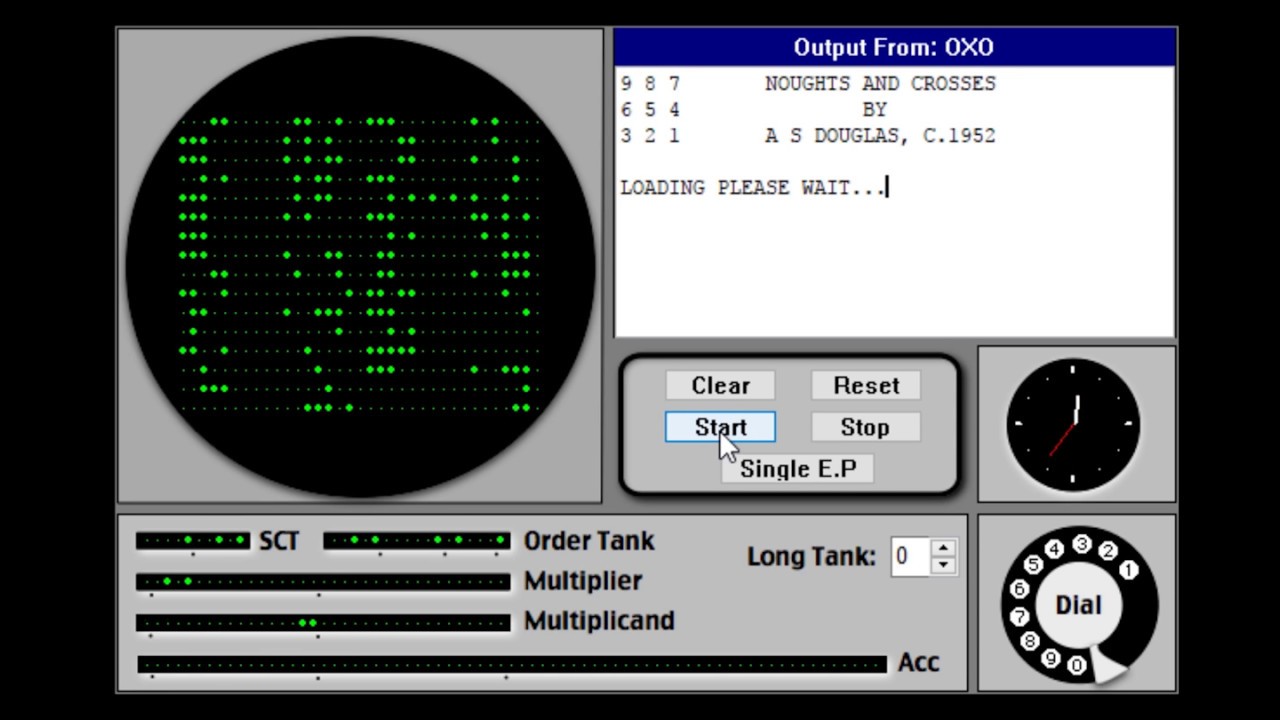The Origin of OXO
Before the advent of modern video games and high-tech consoles, there was OXO, also known as Noughts and Crosses. This simple game holds the distinction of being one of the first video games ever created. OXO originated in the mid-20th century and has since become a beloved classic.
The game itself is played on a grid of nine squares, arranged in a 3×3 formation. Two players take turns marking their symbol – the cross or the nought – in an attempt to create a line of three of their symbols either horizontally, vertically, or diagonally.
OXO traces its roots back to ancient times, where similar games were played with pen and paper. However, it wasn’t until the mid-1950s that the concept was transformed into an electronic version.
The credit for the creation of OXO goes to Alexander Douglas, a British computer scientist. In 1952, while pursuing his Ph.D. at the University of Cambridge, he developed and implemented OXO on the EDSAC (Electronic Delay Storage Automatic Calculator), one of the earliest computers in existence.
Douglas saw the potential of the computer as a tool for gaming and decided to create a version of Noughts and Crosses that could be played digitally. It was a groundbreaking achievement, as OXO became the first-ever video game to be constructed on a computer.
While the gameplay of OXO may seem elementary by today’s standards, it was a revolutionary concept at the time. The ability to play a game on a computer, even a simple one like Noughts and Crosses, paved the way for the future of gaming.
Despite its primitive graphics and limited functionality, OXO captivated the imaginations of those who had the opportunity to play it. It showcased the potential of computer-powered entertainment and laid the groundwork for the myriad of video games we enjoy today.
The Game Rules
The rules of OXO, also known as Noughts and Crosses, are straightforward and easy to grasp. The game is played on a 3×3 grid, and two players take turns marking their symbol – either a cross or a nought – in one of the empty squares.
The objective of the game is to create a line of three of your symbols either horizontally, vertically, or diagonally. The first player to achieve this wins the game. If all nine squares are filled and no player has achieved a winning combination, the game is declared a draw.
At the beginning of the game, the grid is empty. The first player, usually designated as “X,” places their symbol in any one of the squares. The second player, often referred to as “O,” then takes their turn and places their symbol in a different empty square.
The players continue taking turns, each placing their symbol in an empty square, until one player manages to create a line of three of their symbols. The line can be horizontal, vertical, or diagonal, but it must be unbroken – no other symbols can be present in between.
If a player successfully creates a line of three, they are declared the winner. The game then ends, and players have the option to start a new round if they wish.
If all nine squares are filled, and no player has achieved a winning line, the game is declared a draw. This scenario often occurs when both players play strategically and prevent the other from forming a winning combination.
The simplicity of the game rules is what makes OXO accessible to players of all ages. Its straightforward gameplay allows for quick and engaging matches, making it a timeless classic that continues to be enjoyed by people around the world.
The Mechanics Behind OXO
As one of the earliest computer games, OXO, or Noughts and Crosses, relied on simple mechanics to bring the game to life on screens. Understanding the mechanics behind OXO provides insight into the development of video games and the technological limitations of the time.
At its core, OXO is a turn-based game that utilizes a grid system. The game’s mechanics involve tracking player moves, validating the game state, and determining outcomes such as wins or draws.
In the original implementation of OXO on the EDSAC computer, the game utilized an array or matrix to represent the 3×3 grid. Each cell in the grid stored the state of the square, indicating whether it was occupied by a cross, a nought, or was empty.
When a player made a move, the computer would update the corresponding value in the matrix to represent their symbol. This updating process allowed the game to keep track of the state of the board and determine the outcome of each turn.
To validate the game state and detect winning combinations, the OXO program implemented a series of logical checks after each move. For example, it would examine the rows, columns, and diagonals of the grid to identify if any player had achieved a line of three symbols.
If a winning combination was detected, the program would declare the corresponding player as the winner. Conversely, if all nine squares were filled, and no winning combination was found, the game would be declared a draw.
The simplicity of the mechanics in OXO reflects the limited capabilities of early computers. The EDSAC, with its primitive processing power and memory limitations, could only handle basic operations. Yet, even within these constraints, the game managed to captivate and entertain players.
The mechanics behind OXO laid the foundation for future advancements in video game technology. It demonstrated the potential of computers to simulate gameplay and became an early example of how games could be implemented and enjoyed digitally.
While OXO’s mechanics may seem rudimentary compared to the complex systems in modern video games, it is important to recognize the significance of this early experimentation. The exploration of game mechanics in OXO ultimately paved the way for the development of more sophisticated and immersive gaming experiences in years to come.
The First Computer Implementation
The first computer implementation of OXO, also known as Noughts and Crosses, was a groundbreaking achievement that marked a significant milestone in the history of video games. It was Alexander Douglas, a British computer scientist, who developed and implemented the game on the EDSAC, one of the earliest computers of its time.
In 1952, Douglas was pursuing his Ph.D. at the University of Cambridge when he saw the potential to use the computer for gaming. Inspired by the traditional pen-and-paper game of Noughts and Crosses, Douglas set out to create a digital version that could be played on the EDSAC.
Implementing the game on the EDSAC was no small feat. In those days, computers were gigantic, filled entire rooms, and had limited processing power and memory capacity. However, despite these constraints, Douglas managed to successfully create a working version of OXO.
The implementation of OXO on the EDSAC utilized the computer’s capabilities to represent the grid and track player moves. The game was coded to recognize player input and update the state of the grid accordingly.
While the graphics and user interface were far from what we envision in today’s games, the EDSAC implementation of OXO displayed the grid on a cathode-ray tube (CRT) display, which was considered groundbreaking at the time. Players would interact with the game using the computer’s keyboard.
Douglas’s implementation of OXO on the EDSAC demonstrated the potential of computers as platforms for interactive and entertaining experiences. It showcased the ability to digitize traditional games and introduced the concept of gaming as a computerized form of entertainment.
Though OXO was a simple game, its implementation on the EDSAC left a lasting impact. It paved the way for the development of more complex and visually immersive games in the future, laying the foundation for the modern video game industry as we know it today.
Considering the technological limitations of the time, the first computer implementation of OXO was a remarkable achievement. It showcased the ingenuity and creativity of early computer scientists like Alexander Douglas and set the stage for the evolution of video games into the diverse and dynamic industry we see today.
The Evolution of OXO
The game of OXO, or Noughts and Crosses, has seen various evolutions and adaptations throughout its history. From its humble beginnings as a computer implementation on the EDSAC to its modern iterations, OXO has left a lasting impact on the world of gaming.
After Alexander Douglas’s groundbreaking implementation of OXO on the EDSAC in the 1950s, the game continued to be explored and expanded upon. The simplicity and accessibility of OXO made it a popular choice for early developers who sought to showcase the potential of computers and their ability to entertain.
As technology advanced, OXO found its way onto different computer systems, from mainframes to personal computers. The game was often included in the software packages of these machines, serving as a demonstration of their capabilities.
In the 1970s and 1980s, as video game consoles and home computers became more widely available, OXO experienced a resurgence in popularity. It was frequently included as part of game collections or as a standalone game on early gaming platforms.
With the advent of the internet and the rise of online gaming, OXO found a new home in the digital realm. Online versions of the game allowed players from around the world to compete against each other in real-time, further extending the reach and longevity of OXO.
In recent years, OXO has also made its way onto mobile devices. Smartphone apps and online game platforms offer portable and convenient ways to enjoy the game on the go. Players can compete against computer opponents or challenge friends and family in multiplayer modes.
Despite the advancements in technology and the availability of more graphically sophisticated games, the allure of OXO remains. Its simplicity and strategic gameplay continue to captivate players of all ages, making it a timeless classic in the world of gaming.
The evolution of OXO serves as a testament to the enduring appeal of the game. It has remained relevant throughout the decades, transcending the constraints of early computers and proving that the simplest of games can stand the test of time.
Today, OXO continues to be enjoyed by millions of players around the world, whether in its traditional pen-and-paper form or in high-tech digital adaptations. Its legacy as one of the first video games ever created solidifies its place in gaming history and ensures that OXO will continue to be cherished by generations to come.
OXO’s Impact on Video Game Industry
The introduction of OXO, or Noughts and Crosses, as one of the first video games ever created had a significant impact on the video game industry, paving the way for the development of countless games and shaping the way we perceive and interact with digital entertainment.
OXO served as a proof of concept for using computers as gaming platforms. Alexander Douglas’s implementation of the game on the EDSAC showcased the potential of computers to simulate and facilitate interactive gameplay. This early exploration opened the floodgates for future advancements in the field of video game development.
The success of OXO laid the groundwork for the creation of more complex and visually immersive games. Developers began iterating on the ideas and mechanics introduced in OXO, leading to the birth of iconic games like Pong, Space Invaders, and Super Mario Bros.
Moreover, OXO’s simplicity and accessibility allowed it to capture the attention of a wide audience. As the game spread, it popularized the notion of gaming as a form of entertainment that could be enjoyed by anyone, regardless of age or technical expertise.
As the video game industry expanded, OXO continued to influence future generations of game developers. It introduced concepts such as turn-based gameplay, grid-based mechanics, and strategic thinking that became foundational elements in various genres of video games, including puzzle games, strategy games, and even role-playing games.
Additionally, OXO’s impact can be seen in the rise of multiplayer gaming. The game’s competitive nature laid the groundwork for future multiplayer experiences, inspiring developers to explore ways to connect players and enable them to challenge each other in real-time or take part in cooperative gameplay.
Furthermore, OXO’s implementation on the EDSAC demonstrated the potential of video games to engage and captivate players, paving the way for the industry’s growth and transformation into a multi-billion dollar global entertainment phenomenon.
Today, OXO remains a symbol of the industry’s humble beginnings. It holds a special place in the hearts of gamers and serves as a reminder of the creativity, innovation, and technological advancements that have propelled the video game industry forward.
The impact of OXO on the video game industry cannot be overstated. It marked the beginning of a revolution, inspiring generations of game developers and gamers alike. The spirit of OXO lives on in the diverse and expansive world of video games, cementing its place as a historical and influential milestone in the ever-evolving medium of digital entertainment.




